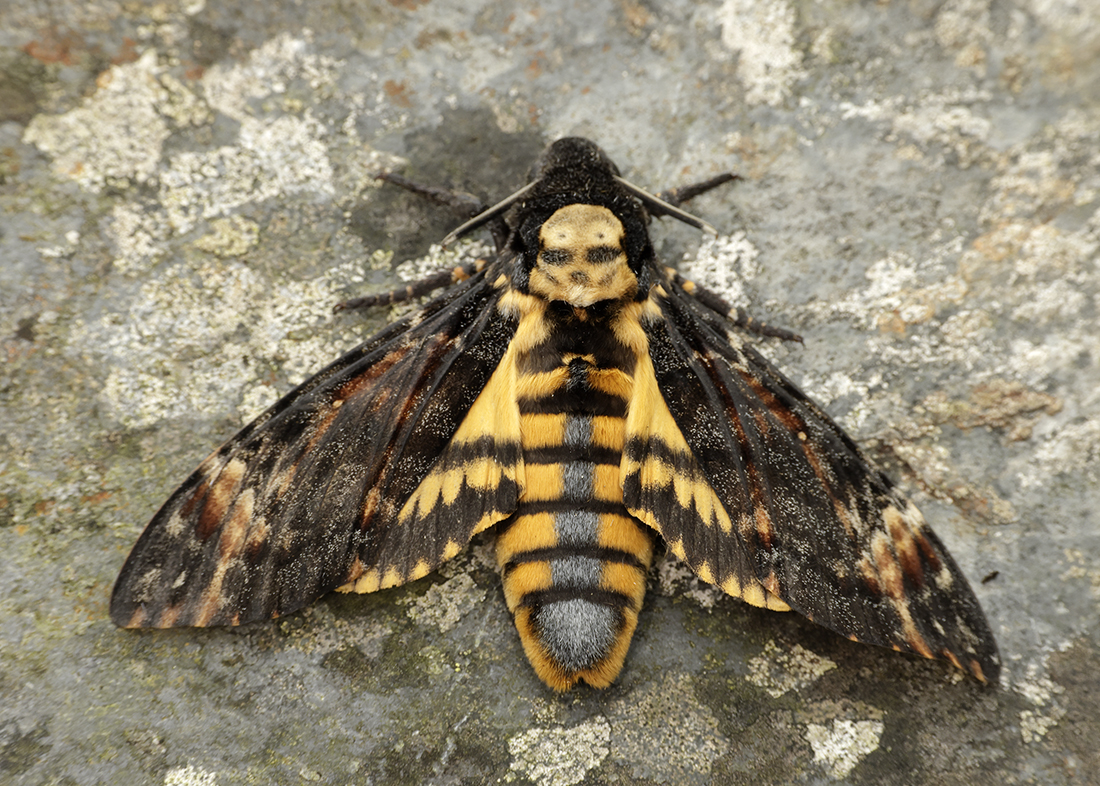Identification
Unmistakable with a skull-like pattern on the thorax.The species name atropos relates to death, and is named after the Greek goddess Atropos. Atropos was one of the three Moirai, goddesses of fate and destiny.
Recording Method
Attracted to light. Sometimes found by day or in beehives, which it can enter to feed on honey without being attached by the bees.
Life cycle
Unable to overwinter.
Larval foodplants
Potato and Deadly Nightshade.
Habitat
Potato fields in days gone by, but with the use of pesticides it is no longer to be found as a resident.
History
Our first was recorded in the Kirkcudbrightshire Advertiser as follows: ‘Dr. Bennett, Dundrennan Abbey, has caught a very fine specimen of the Acherontia Atropos, or Death’s-head Moth, in his premises. This moth is the most remarkable of our native Lepidoptera – specimens of it occasionally attain to the size of the common bat, and it has the image of the human skull very distinctly marked upon its back. The specimen in question weighs 40 grains, measures fully three inches in length, and when the wings are extended six inches from tip to tip; when caught it emitted a sort of snorting and squeaking sound fully as loud as a mouse. When first seen it was mistaken for a bat and was very lively and quick in its movements. It evinced a considerable partiality for flowers. One or two other specimens of this moth have this season been seen in this neighbourhood, next the Doon Cottage.’
On 27th September 1868 one was found on the overnight mail train in Dumfries station and ended up in the collection of William Lennon.
Thomas Rae Bruce informed Robert Service of a larva he had found at Cairnryan (VC74) on 24th August 1896, while he himself had a greenish-type larva that was found in a potato field at Cluden (VC72) on 4th September 1897 (Ann. Scot. Nat. Hist. 1897: 257-258). Gordon (1913) had larvae records from Stranraer, Port William and Whithorn (VC74) and one of an adult at Quhillart Farm, Corsemalzie, in mid-July 1898. Robert Service also saw one in 1898 climbing up a wall at Laurieknowe (VC72) which he climbed up after and secured it. In 1899 nine were recorded of which two were adults, one pupa which was dug up, with the rest being larvae, followed by eight records in 1900. From 1901-08 there were a further eight records. All of the above records from 1899 onwards were in Dumfriesshire or Kirkcudbrightshire.
A further eight records were recorded during 1943-49. In 1950 two more adults were found in Dumfriesshire and one at Garlieston, Wigtownshire, which then had another in September, 1953 at Whithorn. The last notice is of one found dead in a porch in Port William, Wigtownshire, during July 1983. MOGBI (1983) had only noticed it in Dumfriesshire.




![69.005 Death's-head Hawk-Moth [not Collected In D&G, 2023] (SWSEIC)](https://dgmoths.info/wp-content/uploads/69005-Deaths-head-hawk-Moth-not-collected-in-DG-2023-SWSEIC.jpg)
